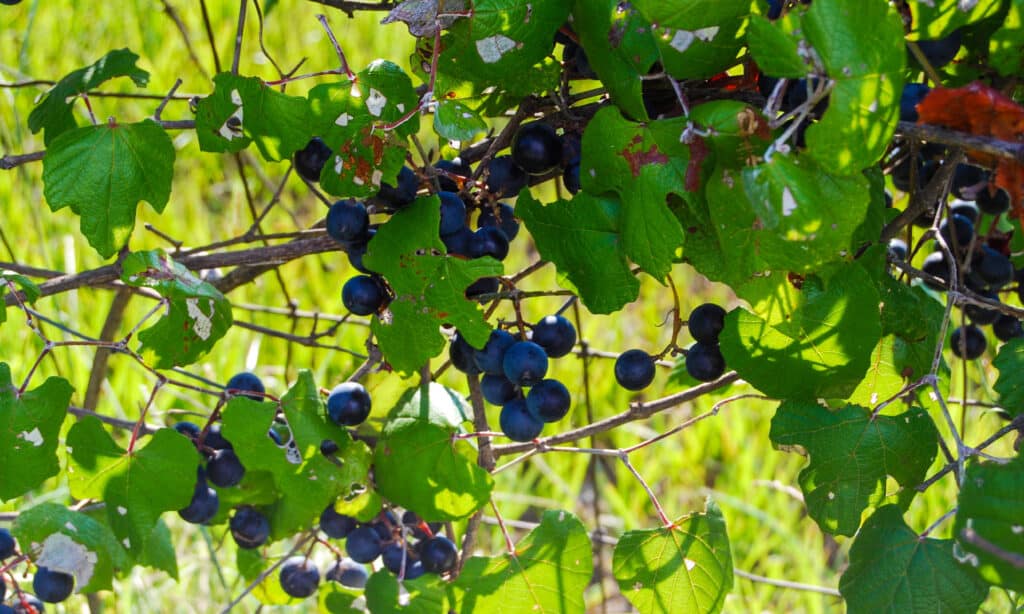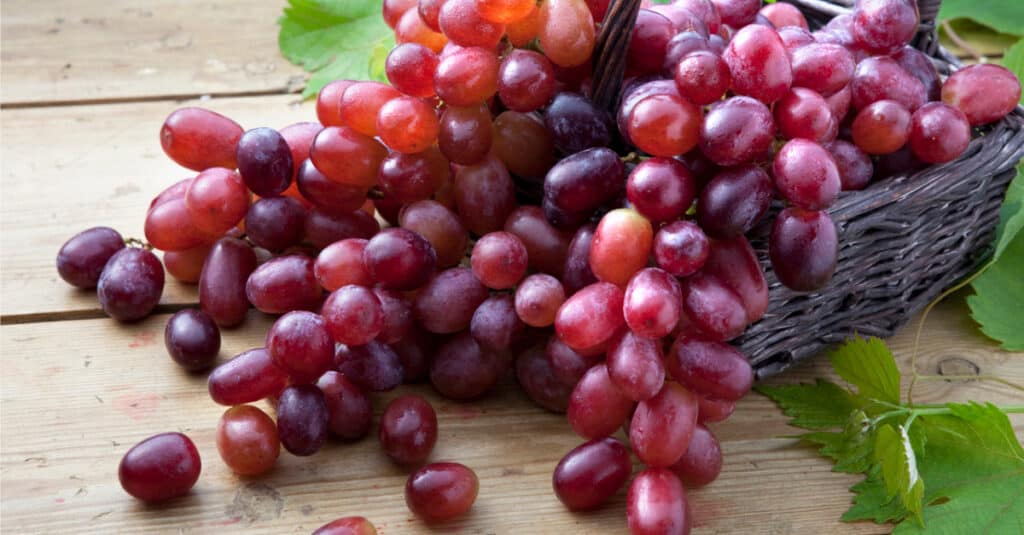Do you enjoy grapes? The common European grape is cultivated worldwide to manufacture wine. The fruits can also be dried to make raisins even though they are typically thought of as wine grapes. Nevertheless, this species produces less-than-ideal table or fresh grapes, therefore it is not usually grown for this use in commerce. However, they are still very much edible.
The grape plant has clasping tendrils that aid in keeping the vines off the ground, like many other plants that climb. The leaves have three to seven lobes and are carried on long stalks. Each leaf has rough teeth on the edges, and there are small hairs on the undersides. The fruits come in a variety of sizes, shapes, and hues. Early spring is the optimum time to plant these vines because of their quick pace of development.
If you’ve been thinking about growing your own grapes to make wine or dry for raisins, we can help! This guide will explore some interesting facts about the grape as well as how to grow your very own vines.
The Botanical Name and History of Grapes
Grapes are basically any species within the Vitis genus of fruiting plants. However, the species Vitis vinifera, also known as the common grape vine, is the main species that is cultivated commercially and in home gardens around the world. The common grape is a type of flowering plant that is indigenous to the Mediterranean area, Central Europe, and southwestern Asia, ranging from Morocco and Portugal in the north to southern Germany in the south and northern Iran in the east.
Neolithic foragers and early farmers collected wild grapes for food. The fruit has been gathered for thousands of years for its medicinal and nutritional benefits; its history is closely related to the history of wine. In prehistoric or early historic periods, cultivation of the grape spread to various regions of the Old World. The Epic of Gilgamesh, a prehistoric Sumerian piece of literature from the third millennium BC, contains the first known written descriptions of grapes and wine. Many hieroglyphic references from ancient Egypt also claim that only priests, officials, and pharaohs were permitted to drink wine made from grapes. To put it simply, grapes are very old plants that have been used for thousands of years. Today, grapes are cultivated commercially across the globe. Countries like Italy, China, and Spain are the main exporters of commercially-grown grapes.
There are presently between 5,000 and 10,000 different varieties of Vitis vinifera grapes, although only a small number are economically significant for the production of wine and table grapes. These are ones that create tasty wines and thrive in certain climate conditions. The French Chardonnay white grape is easier to cultivate in a larger range of North American locations because it is more cold-hardy than many other Vitis vinifera cultivars. While it consistently yields early-ripening fruit, it is quite prone to bunch rot. The German-born Pinot Blanc grape is another excellent wine grape. Although this white wine grape is not as susceptible to bunch rot issues as Chardonnay, it is similarly cold-hardy. The Pinot Noir grape variety, which ripens early and is generally cold-hardy, is renowned for producing high-quality red table wines. Regrettably, it is yet another plant that bunch rot can negatively affect. To produce a profitable harvest, careful vine management in terms of trimming and air circulation is required for this cultivar.

Mustang grapes (pictured) are another species of grapes that are popular in the United States.
©CatherineTheGreat/Shutterstock.com
Climate and Hardiness Zone Requirements for Grapes
Grapes are hardy in USDA hardiness zones six through nine. For healthy vine development and the production of grapes of the highest caliber, sufficient sun, heat, and water must be provided throughout the growing season, as well as sufficient cold during the dormant period. The optimal conditions for grapevine growth are long, warm summers and wet winters. The ability of grapevines to blossom, set fruit, and mature depends on warm temperatures during the growing season. Depending on the growing location and vine variety, grapevines need between 1400 and 2220 growth days at temperatures over 50 degrees F in order to ripen correctly.
When to Grow Grapes
If irrigation is available, very late winter or early spring is the ideal time to grow grape vines in the majority of the United States. Prior to planting in the spring, order vines from a reputed nursery in the summer or early fall to guarantee the best cultivar or rootstock. If you make your purchase in January or February, there can be issues with plant availability or quality. For instance, the best-rooted cuttings will likely be scooped up by other growers, and the remaining poor-quality vines will likely not be able to survive. The nursery should send the vines at or close to the time you want to plant them. When vines have arrived, they should ideally be planted right away rather than being stored.
Starting Grapes From Seed vs. Buying Adult Plants
Buying adult grape vines will save you a bit of time in the long run. However, growing grapes from seed can be a very fun and fulfilling process; just keep in mind that it will require some patience.
Common grapes cultivated from seed might take up to one year to germinate. To improve the likelihood of effective germination, seeds should be sown in a cold frame and exposed to low temperatures for one to two months before planting.
Cuttings from mature, dormant grape wood are another common method for growing grapes. The cutting should be around one foot long, have a few buds, and ideally be from growth that is a year old. The cutting can be placed in damp but not saturated soil after being dipped in rooting hormone. Planting more cuttings than you need is always a smart idea because not all of them will likely take.
How to Grow Grapes
Researching before planting grapes in your yard will pay off because growing needs might vary greatly depending on the cultivar chosen. However, in general, the growth requirements of grapes are generally the same across cultivars. Choose a spot for planting that is protected from strong and chilly winds. Avoid areas with known frost pockets since late spring frosts can cause harm to nascent vegetation.
To provide a decent harvest and lower the prevalence of fungus-based illnesses, it is crucial to properly space, prune, and train the vines. The majority of grape varieties require many seasons to produce a harvestable crop. Once more, it’s crucial to do your own research on your specific grape variety to understand the specific needs of your plant and staking systems, as well as effective pruning methods for the first few years of development.
The common grape is a high-maintenance crop because of the numerous illnesses and insect pests that tend to assault it. Pests such as beetles, moths, mealybugs, and leafhoppers can seriously damage grape plants. It would be wise to install netting as the vines become older and start to produce fruit in order to keep birds and other animals from eating your laboriously earned harvest. In addition to pests, diseases like black rot, bunch rot, and mold infections can damage grape vines that are kept too damp.
With these negatives in mind, the common grape is self-pollinating, which eliminates the need to grow extra vines for pollination. That’s good news, at least!

Grapes (pictured) are susceptible to pests and illness, and thus should be carefully monitored as they grow.
©iStock.com/darrenplatts123
Soil and Fertilizer Requirements for Grapes
The common grape needs well-drained soil in line with its original Mediterranean environment. Just as well, it will value a place with loamy soil that is rich in organic matter. If your grapes are already growing in soil that is rich in organic matter, you could complement this natural fertilizer every year when the first spring growth occurs with around half a cup of a balanced fertilizer. Apply the same quantity of fertilizer again after four weeks in the plant’s first year. Put the fertilizer up to one foot away from the plant’s base. It is preferable to distribute it evenly across the region that is four to five feet out from the base. This method encourages excellent root growth.
Water Requirements for Grapes
Give your grapes enough water, but not too much. During droughts, water your crops thoroughly. Keep the soil consistently wet. A crucial first step in avoiding overwatering is providing excellent drainage so that the water you provide your grapes can filter out and not cause root rot.
Temperature and Humidity Requirements for Grapes
Due to their reputation for being less cold-hardy than American grape species, Vitis vinifera cultivars often thrive in areas with hardiness zones of six and higher. That being said, certain cultivars are recognized as being more cold-resistant than others. In general, in order to produce a decent crop, grapes often require a lengthy, warm environment. This grape species also does not handle excessive humidity well due to its tendency for fungal illnesses.
Sunlight Requirements for Grapes
For the finest yield, the common grape requires full, direct sunlight. Usually, vines planted on a small southeast-facing slope yield well.
How Long Do Grapes Take to be Ready for Harvest?
Grape harvesting typically begins 30 to 70 days following fruit set, when the color of the berries shifts from green to yellow or red to purple. Typically, during this time, the fruits’ sugar content rises while their acid content falls. In general, most cultivars and species develop in the northern hemisphere between August and November, whereas they do so between March and August in the southern hemisphere.
The ideal time to harvest grapes, nevertheless, is difficult to determine. The quality of the finished wine or raisin product is greatly influenced by the environment, the soil, the position of the grape variety, and the growing methods used. In order to attain the appropriate quality, producers harvest various cultivars or varieties at various maturation stages. In the end, the only way to tell if your grapes are ready is to pop one in your mouth and taste it for yourself.
Grape Companion Plants
There are many great pollinating plants that do well when planted along with grapes, such as hyssop. Geraniums are another great plant that can repel pests that tend to attack grapevines. Clover, basil, and oregano plants are great for improving soil quality near grapevines.
If you live in the right hardiness zone and can provide your plants with the specific ongoing needs required to keep them healthy, keeping grapes really isn’t that difficult. With a little patience, you could be enjoying fresh grapes for years to come.
The photo featured at the top of this post is © Ton Photographer 4289/Shutterstock.com
FAQs (Frequently Asked Questions)
How long do grapes take to grow?
Grape vines can take up to seven years to fruit, though many will start fruiting within two years.
What type of plant are grapes?
Grapes are perennial woody vining plants.
Can you grow grapes from seed?
Sure. You’ll need to be patient when it comes to germination, but grapes are very easy to grow from seed.
Thank you for reading! Have some feedback for us? Contact the AZ Animals editorial team.






